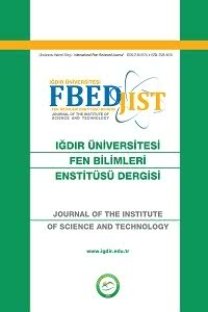Some Important Fruit Characteristics of Apricot (cv. Aprikoz) Accessions Grown in Kagizman District in Turkey
Apricot, diversity, phytochemicals, breeding
Some Important Fruit Characteristics of Apricot (cv. Aprikoz) Accessions Grown in Kagizman District in Turkey
Apricot, diversity, phytochemicals, breeding,
___
- Akin EB, Karabulut I, Topcu A, 2008. Some compositional properties of main Malatya apricot (Prunus armeniaca L.) varieties. Food Chemistry, 107: 939-948.
- Ali S, Masud T, Abbasi KS, 2011. Physico-chemical characteristics of apricot (Prunus armeniaca L.) grown in Northern Areas of Pakistan. Scientia Horticulture, 130 (2): 386-392.
- Asma BM, Ozturk K, 2005. Analysis of morphological, pomological and yield characteristics of some apricot germplasm in Turkey. Genetic Resources and Crop Evolution, 52: 305-313.
- Atis E, Celikoglu S, 2017. Apricot producing in Kagizman district and its contribution to the economy of territory. Marmara Geographical Journal, 36: 191-205.
- Benzie, I.F.F., Strain, J.J., 1996. The ferric reducing ability of plasma (FRAP) as a measure of “antioxidant power”: the FRAP assay. Analytical Biochemistry, 239: 70-76.
- Dragovic-Uzelac, V., Levaj, B., Mrkic, V., Bursac, D., Boras, M., 2007. The content of polyphenols and carotenoids in three apricot cultivars depending on stage of maturity and geographical region. Food Chemistry, 102: 966-975.
- Drogoudi, P.D., Vemmos, S., Pantelidis, G., Petri, E., Tzoutzoukou, C., Karayiannis, I., 2008. Physical characters and antioxidant, sugar, and mineral nutrient contents in fruit from 29 apricot (Prunus armeniaca L.) cultivars and hybrids. Journal of Agriculture and Food Chemistry, 56: 10754-10760.
- Ercisli S, 2009. Apricot culture in Turkey. 2009. Scientific Research and Essays, 4:715-719.
- FAO (2019). Crop Statistical database. Crop Statistical database.
- Gazdik Z, Reznicek V, Adam V, Zitka O, Jurikova T, Krska B, Matuskovic J, Plsek J, Saloun J, Horna A, Kizek R, 2008. Use of liquid chromatography with electrochemical detection for the determination of antioxidants in less common fruits. Molecules, 13: 2823-2836.
- Gecer MK; Kan T, Gundogdu M, Ercisli S, Ilhan G, Sagbas HI (2020). Physicochemical characteristics of wild and cultivated apricots (Prunus armeniaca L.) from Aras valley in Turkey. Genetic Resources and Crop Evolution, 67: 935-945.
- Gulcan R, Mısırlı A, Sağlam H, Yorgancıoğlu U, Erkan S, Gümüs M, Ölmez HA, Derin K, Paydaş S, Eti S, Demir T, (2006) Properties of Turkish apricot landraces. Acta Horticulturae, 701: 191-198.
- Gurrieri F, Audergon JM, Albagnac G, Reich M, 2001. Soluble sugars and carboxylic acids in ripe apricot fruit as parameters for distinguishing different cultivars. Euphytica, 117:183-189.
- Hegedus A, Engel R, Abranko L, Balogh E, Blazovics A, Herman R, Halasz J, Ercisli S, Pedryc A, Stefanovits-Banyai E, 2010. Antioxidant and antiradical capacities in apricot (Prunus armeniaca L.) fruits: Variation from genotypes, years, and analytical methods. Journal of Food Science, 75 (9):C722–C730.
- Kelebek H, Selli S, 2011. Determination of volatile, phenolic, organic acid and sugar components in a Turkish cv. Dortyol (Citrus sinensis L. Osbeck) orange juice. Journal of the Science of Food and Agriculture, 9: 1855-1862.
- Leccese A, Viti R, Bartolini S, 2011. The effect of solvent extraction on antioxidant properties of apricot fruit. Central European Journal of Biology, 6(2):199-204.
- Lingdi L, Bartholomew B, 2003. Armeniaca. In: Flora of China (eds Wu CY, Raven PH), pp. 396–401. Science Press and Missouri Botanical Garden Press, Beijing.
- Munzuroglu O, Karatas F, Geckil H, 2003. The vitamin and selenium contents of apricot fruit of different varieties cultivated in different geographical regions. Food Chemistry, 83:205-212.
- Polat AA, Yilmaz M, 1988. Investigations on the adaptations of some native and foreign apricot cultivars to Adana ecological conditions. Journal of Science and Engineering, 2: 127-146.
- Polat AA, Durgac C, Kamiloglu O, Caliskan O, 2004. Investigation on the adaptation of some low-chill apricot cultivars to Kirikhan (Turkey) ecological conditions. Acta Hortuculturae, 636:395-400.
- Ronggao G, Wei Y, Zhihui W, Mingan L, Guolu L, 2015. Study on the sugar-acid ratio and relevant metabolizing enzyme activities in navel orange fruits from different eco-regions. Revista Brasileria de Fruticultura, 37:835-844.
- Ruiz D, Egea J, Tomas-Barberan FA, Gil MI, 2005. Carotenoids from new apricot (Prunus armeniaca L.) varieties and their relationship with flesh and skin color. Journal of Agricultural and Food Chemistry, 53: 6368-6374.
- Sass-Kiss A, Kiss J, Milotay P, Kerek MM, Toth-Markus M. 2005. Differences in anthocyanin and carotenoid content of fruits and vegetables. Food Research International, 38: 1023-1029.
- Selamoglu Z, Erdemli ME, 2017. The significance of apricot in human health and nutrition. Biochemistry & Molecular Biology Journal, 3:2??
- Serrano, M., Diaz-Mula, H.M., Zapata, P.J., Castillo, S., Guillen, F., Martinez-Romero, D., Valverde, J.M., Valero, D., 2009. Maturity stage at harvest determines the fruit quality and antioxidant potential after storage of sweet cherry cultivars. Journal of Agriculture and Food Chemistry, 57: 3240-3246.
- Singleton, V.L., Rossi, J.A., 1965. Colorimetry of total phenolics with phosphomolybdic- phosphotungstic acid reagents. American Journal Enology and Viticulture, 16:144-158.
- Sochor, J., Zitka, O., Skutkova, H., Pavlik, D., Babula, P., Krska, B., Horna, A., Adam, V., Provaznik, I., Kizek, R. (2010). Content of phenolic compounds and antioxidant capacity in fruits of apricot genotypes. Molecules, 15(9):6285-6305.
- Yilmaz, K.U., Paydas Kargi, S., Kafkas, S., 2010. Morphological diversity of the Turkish apricot (Prunus armeniaca L.) germplasm in the Irano-Caucasian ecogeographical group. Turkish Journal of Agriculture and Forestry, 36:688-694.
- Yilmaz KU, Gurcan K, 2012. Genetic diversity in apricot. In: Genetic Diversity in Plants (ed. Caliskan M), pp. 249–270. InTech Europe, Rijeka, Croatia. ISBN: 978-953-51-0185-7. http://www.intechopen.com/books/geneticdiversity-in-plants/genetic-diversity-in-apricot.
- ISSN: 2146-0574
- Yayın Aralığı: 4
- Başlangıç: 2011
- Yayıncı: -
Bir Hafif Raylı Ulaşım Sisteminde Makinist Çizelgeleme Problemi
Zeynep CEYLAN, Merve ARSLAN, Tuba ARSLAN
A_{p1,q1}^{p2,q2}(G,w) Uzayı ve Bazı Topolojik Özellikleri Üzerine
Nilay DEĞİRMEN, İbrahim DEĞİRMEN
Ayhan ELMASTAŞ, Adil UMAZ, Fırat AYDIN
Mineral Composition of Various Extracts and Essential Oil of Pickled Ferula orientalis L
Elif Feyza TOPDAS, Memnune ŞENGÜL
Muhammet YILMAZ, Fatih TOSUNOĞLU, Mehmet Cüneyd DEMİREL
Güçlendirme Ankrajlarının Kesme Performansının Mevcut Yığma Duvarlar Üzerinde Belirlenmesi
